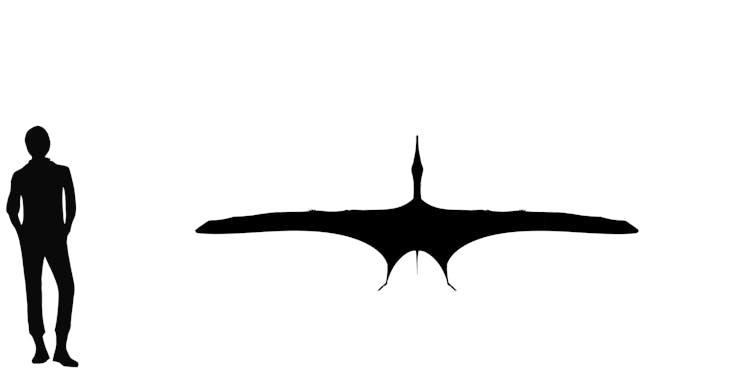


In 2006 Lü Junchang and colleagues named a new pterosaur, Yixianopterus jingangshanensis, from the Lower Cretaceous Yixian Formation in Liaoning, China. It’s known from a single partial specimen that was found in the Jingangshan Beds of the formation. Lü and colleagues’ description of the specimen is preliminary and the fossils remain poorly photographed and illustrated to this day.
The only known specimen is incomplete, with the tips of both jaws, the majority of both wings, and one leg being present. There appear to be a number of possible bone fragments in the center of the specimen that might represent parts of the limb girdles, but they are not mentioned by the authors. The limbs remain articulated, and they stayed in life position before burial as did the skull. Before the specimen was acquired by the Jinzhou Museum, private dealers glued several bone fragments to the limestone slab behind jaw tips creating a fearsome and “complete” but forged skull. The researchers readily identified the forgery and only describe the the genuine skull material.
The skull is only known from of the tips of both the upper and lower jaws. The fragments are about 7 cm (3 inches) long, straight, and have several teeth in both jaws. Each tooth is a somewhat blunt recurved cone, with the tip of each tooth directed inward. They’re all roughly the same size, about 7 mm (1/4 inch) with those at the very tip slightly longer at about 12 mm (1/2 inch). Between each tooth is a gap roughly the same length as the diameter of the teeth.
Lü and colleagues noted similarities between the teeth of Yixianopterus and the lonchodectids, a rare and poorly understood family of Cretaceous pterosaurs. Lonchodectids have distinctive teeth and jaws, where the teeth emerge from low bony pedestals or collars. In Yixianopterus, the oral margins of both jaws are poorly fossilized so it’s unknown if the teeth emerged from bony collars and their exact length.
Both wings are almost entirely complete and articulated, lacking both humeri, both pteroid bones, and most of the non-wing hand and finger bones. The proportions of the wing bones are distinctive, showing that Yixianopterus had a somewhat short hand and long second wing finger phalanx. The joints between individual wing finger phalanges show that the wing finger was not very flexible in life. There are portions of one femur and tibia, but they are poorly fossilized and not very informative. Yixianopterus was a medium-sized pterosaur with a wingspan of about 1.8 meters (6 feet), similar to larger species of herons, pelicans, and gulls.
When the Yixian Formation was deposited about 120 million years ago, northeastern China was covered in temperate forests with a large number of lakes and rivers. Because of their mysterious nature, the diet and behavior of lonchodectids is unknown. All known lonchodectid specimens have long and extremely narrow jaws, resembling toothed scissors. Their distinctive jaws and teeth suggest that they were specialized carnivores, possibly probing in tight spaces for small invertebrates, or scavenging carcasses.
